44 start with C start with C
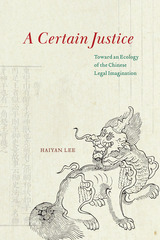
To many outsiders, China has an image as a realm of Oriental despotism where law is at best window dressing and at worst an instrument of coercion and tyranny. In this highly original contribution to the interdisciplinary field of law and humanities, Haiyan Lee contends that this image arises from a skewed understanding of China’s political-legal culture, particularly the failure to distinguish what she calls high justice and low justice.
In the Chinese legal imagination, Lee shows, justice is a vertical concept, with low justice between individuals firmly subordinated to the high justice of the state. China’s political-legal culture is marked by a mistrust of law’s powers, and as a result, it privileges substantive over procedural justice. Calling on a wide array of narratives—stories of crime and punishment, subterfuge and exposé, guilt and redemption—A Certain Justice helps us recognize the fight for justice outside the familiar arenas of liberal democracy and the rule of law.

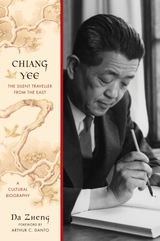
This biography is more than a recounting of extraordinary accomplishments. It also embraces the transatlantic life experience of Yee who traveled from China to England and then on to the United States, where he taught at Columbia University, to his return to China in 1975, after a forty-two year absence. Interwoven is the history of the communist revolution in China; the battle to save England during World War II; the United States during the McCarthy red scare era; and, eventually, thawing Sino-American relations in the 1970s. Da Zheng uncovers Yee's encounters with racial exclusion and immigration laws, displacement, exile, and the pain and losses he endured hidden behind a popular public image.
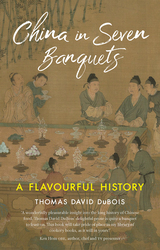
China in Seven Banquets takes readers on a gastronomic adventure into the history of China’s constantly evolving and astonishingly diverse cuisine. From the opulent Eight Treasures feast of ancient times to the Tang dynasty’s legendary “Tail-Burning” banquet, and the extravagant “complete Manchu-Han feast” of the Qing court, these iconic repasts offer glimpses into China’s rich food history. Delving further, the book invites us to partake of lavish banquets immortalized in literature and film, a New Year’s buffet from 1920s Shanghai, a modern delivery menu reflecting the hyperglobal present, and it even offers a peek at the tables of the not-so-distant future. Drawing upon his extensive gastronomic adventures across China, acclaimed historian Thomas David DuBois unravels its ever-changing landscape of culinary trends, revealing why flavors and customs evolved over time. DuBois also recreates dozens of traditional recipes using modern kitchen techniques. Whether indulging in fermented elk or savoring absinthe cocktails, readers embark on an unparalleled odyssey that redefines their perception of Chinese cuisine.
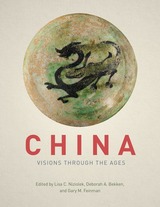
China’s long history is one of the richest and most complex in the known world, and the Cyrus Tang Hall of China offers visitors a wonderful, comprehensive survey of it through some 350 artifacts on display, spanning from the Paleolithic period to present day. Now, with China: Visions through the Ages, anyone can experience the marvels of this exhibition through the book’s beautifully designed and detailed pages. Readers will gain deeper insight into The Field Museum’s important East Asian collections, the exhibition development process, and research on key aspects of China’s fascinating history. This companion book, edited by the exhibition’s own curatorial team, takes readers even deeper into the wonders of the Cyrus Tang Hall of China and enables them to study more closely the objects and themes featured in the show. Mirroring the exhibition’s layout of five galleries, the volume is divided into five sections. The first section focuses on the Paleolithic and Neolithic periods; the second, the Bronze Age, the first dynasties, and early writing; the third, the imperial system and power; the fourth, religion and performance; and the fifth, interregional trade and the Silk Routes. Each section also includes highlights containing brief stories on objects or themes in the hall, such as the famous Lanting Xu rubbing.
With chapters from a diverse set of international authors providing greater context and historical background, China: Visions through the Ages is a richly illustrated volume that allows visitors, curious readers, and China scholars alike a chance to have an enduring exchange with the objects featured in the exhibition and with their multifaceted histories.
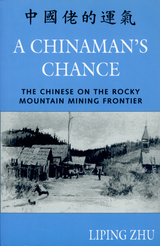
Between 1863 and 1910, a large number of Chinese immigrants resided in the Boise Basin to search for gold. As in many Rocky Mountain mining camps, they comprised a majority of the population. Unlike settlers in many other boom-and-bust western mining towns, the Chinese in the Boise Basin managed to stay there for more than half a century.
Thus, the Chinese portrayed all the stereotypical frontier roles-victors, victims, and villains. Their basic material needs were guaranteed, and many individuals were able to climb up the economic ladder. Frontier justice was used to settle disputes; Chinese-Americans frequently challenged white opponents in the various courts as well as in gun battles.
Interesting and provocative, A Chinaman's Chance not only offers general readers a narrative account of the Rocky Mountain mining frontier, but also introduces a fresh interpretation of the Chinese experience in nineteenth-century America to scholars interested in Asian American studies, immigration history, and ethnicity in the American West.
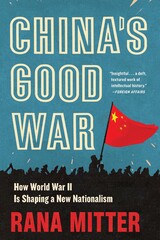
A Foreign Affairs Book of the Year
A Spectator Book of the Year
“Insightful…a deft, textured work of intellectual history.”
—Foreign Affairs
“A timely insight into how memories and ideas about the second world war play a hugely important role in conceptualizations about the past and the present in contemporary China.”
—Peter Frankopan, The Spectator
For most of its history, China frowned on public discussion of the war against Japan. But as the country has grown more powerful, a wide-ranging reassessment of the war years has been central to new confidence abroad and mounting nationalism at home.
Encouraged by reforms under Deng Xiaoping, Chinese scholars began to examine the long-taboo Guomindang war effort, and to investigate collaboration with the Japanese and China’s role in the post-war global order. Today museums, television shows, magazines, and social media present the war as a founding myth for an ascendant China that emerges as victor rather than victim. One narrative positions Beijing as creator and protector of the international order—a virtuous system that many in China now believe to be under threat from the United States. China’s radical reassessment of its own past is a new founding myth for a nation that sees itself as destined to shape the world.
“A detailed and fascinating account of how the Chinese leadership’s strategy has evolved across eras…At its most interesting when probing Beijing’s motives for undertaking such an ambitious retooling of its past.”
—Wall Street Journal
“The range of evidence that Mitter marshals is impressive. The argument he makes about war, memory, and the international order is…original.”
—The Economist
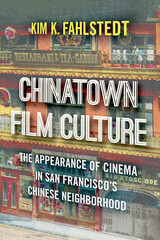
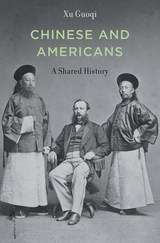
Chinese–American relations are often viewed through the prism of power rivalry and civilization clash. But China and America’s shared history is much more than a catalog of conflicts. Using culture rather than politics or economics as a reference point, Xu Guoqi highlights significant yet neglected cultural exchanges in which China and America have contributed to each other’s national development, building the foundation of what Zhou Enlai called a relationship of “equality and mutual benefit.”
Xu begins with the story of Anson Burlingame, Abraham Lincoln’s ambassador to China, and the 120 Chinese students he played a crucial role in bringing to America, inaugurating a program of Chinese international study that continues today. Such educational crosscurrents moved both ways, as is evident in Xu’s profile of the remarkable Ge Kunhua, the Chinese poet who helped spearhead Chinese language teaching in Boston in the 1870s. Xu examines the contributions of two American scholars to Chinese political and educational reform in the twentieth century: the law professor Frank Goodnow, who took part in making the Yuan Shikai government’s constitution; and the philosopher John Dewey, who helped promote Chinese modernization as a visiting scholar at Peking University and elsewhere. Xu also shows that it was Americans who first introduced to China the modern Olympic movement, and that China has used sports ever since to showcase its rise as a global power. These surprising shared traditions between two nations, Xu argues, provide the best roadmap for the future of Sino–American relations.
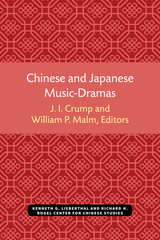

For many Westerners, the words "Chinese art" evoke visions of willow pattern landscapes on porcelain plates and teapots, Chinese wallpaper decorated with flowers, birds, and pagodas, and perhaps silk brocades. This beautiful book allows readers to see beyond such ornamental exports to the true nature of the art produced in China over millennia for a Chinese audience, whether the Emperor, the scholarly elite, the ordinary folk, or the furnishing of tombs and temples.
Drawing on the British Museum's extensive collection, Chinese Art in Detail explores the traditional hierarchy of materials and techniques reaching back as far as the Han Dynasty in the third century B.C.—with calligraphy and painting most revered, followed by jades and bronzes, decorative arts such as lacquer, porcelain, and silk, and, finally, sculpture for religious and funerary use. Images of complete artifacts set against magnified details give readers the rare opportunity to appreciate the delicacies of technique and material that characterize much of Chinese art—and distinguish one form, as well as one period, from another. Illuminated throughout by two scholars thoroughly and deeply versed in the history and character of the works under scrutiny, this sumptuously illustrated book conveys an understanding of Chinese art in all its great variety, its simplicities, its complexities, its splendors, and its mysteries of craft and inspiration reaching back to Neolithic times.
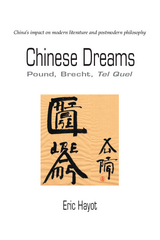
China’s profound influence on the avant-garde in the 20th century was nowhere more apparent than in the work of Ezra Pound, Bertolt Brecht, and the writers associated with the Parisian literary journal Tel quel. Chinese Dreams explores the complex, intricate relationship between various “Chinas”—as texts—and the nation/culture known simply as “China”—their context—within the work of these writers. Eric Hayot calls into question the very means of representing otherness in the history of the West and ultimately asks if it might be possible to attend to the political meaning of imagining the other, while still enjoying the pleasures and possibilities of such dreaming. The latest edition of this critically acclaimed book includes a new preface by the author.
“Lucid and accessible . . . an important contribution to the field of East-West comparative studies, Asian studies, and modernism.”
—Comparative Literature Studies
“Instead of trying to decipher the indecipherable ‘China’ in Western literary texts and critical discourses, Hayot chose to show us why and how ‘China’ has remained, and will probably always be, an enchanting, ever-elusive dream. His approach is nuanced and refreshing, his analysis rigorous and illuminating.”
—Michelle Yeh, University of California, Davis

Winner of the Stanislas Julien Prize
Winner of the Joseph Levenson Prize for Scholarship on Pre-1900 China
Dreaming is a near-universal human experience, but there is no consensus on why we dream or what dreams should be taken to mean. In this book, Robert Ford Campany investigates what people in late classical and early medieval China thought of dreams. He maps a common dreamscape—an array of ideas about what dreams are and what responses they should provoke—that underlies texts of diverse persuasions and genres over several centuries. These writings include manuals of dream interpretation, scriptural instructions, essays, treatises, poems, recovered manuscripts, histories, and anecdotes of successful dream-based predictions.
In these many sources, we find culturally distinctive answers to questions peoples the world over have asked for millennia: What happens when we dream? Do dreams foretell future events? If so, how might their imagistic code be unlocked to yield predictions? Could dreams enable direct communication between the living and the dead, or between humans and nonhuman animals? The Chinese Dreamscape, 300 BCE–800 CE sheds light on how people in a distant age negotiated these mysteries and brings Chinese notions of dreaming into conversation with studies of dreams in other cultures, ancient and contemporary. Taking stock of how Chinese people wrestled with—and celebrated—the strangeness of dreams, Campany asks us to reflect on how we might reconsider our own notions of dreaming.
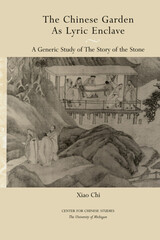
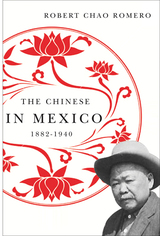
An estimated 60,000 Chinese entered Mexico during the late nineteenth and early twentieth centuries, constituting Mexico's second-largest foreign ethnic community at the time. The Chinese in Mexico provides a social history of Chinese immigration to and settlement in Mexico in the context of the global Chinese diaspora of the era.
Robert Romero argues that Chinese immigrants turned to Mexico as a new land of economic opportunity after the passage of the U.S. Chinese Exclusion Act of 1882. As a consequence of this legislation, Romero claims, Chinese immigrants journeyed to Mexico in order to gain illicit entry into the United States and in search of employment opportunities within Mexico's developing economy. Romero details the development, after 1882, of the "Chinese transnational commercial orbit," a network encompassing China, Latin America, Canada, and the Caribbean, shaped and traveled by entrepreneurial Chinese pursuing commercial opportunities in human smuggling, labor contracting, wholesale merchandising, and small-scale trade.
Romero's study is based on a wide array of Mexican and U.S. archival sources. It draws from such quantitative and qualitative sources as oral histories, census records, consular reports, INS interviews, and legal documents. Two sources, used for the first time in this kind of study, provide a comprehensive sociological and historical window into the lives of Chinese immigrants in Mexico during these years: the Chinese Exclusion Act case files of the U.S. Immigration and Naturalization Service and the 1930 Mexican municipal census manuscripts. From these documents, Romero crafts a vividly personal and compelling story of individual lives caught in an extensive network of early transnationalism.
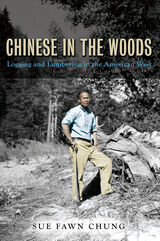


Written Chinese served as a prestigious, cosmopolitan script across medieval East Asia, from as far west as the Tarim Basin to the eastern kingdom of Heian period Japan (794–1185). In this book, Brian Steininger revisits the mid-Heian court of the Tale of Genji and the Pillow Book, where literary Chinese was not only the basis of official administration, but also a medium for political protest, sermons of mourning, and poems of celebration.
Chinese Literary Forms in Heian Japan reconstructs the lived practice of Chinese poetic and prose genres among Heian officials, analyzing the material exchanges by which documents were commissioned, the local reinterpretations of Tang aesthetic principles, and the ritual venues in which literary Chinese texts were performed in Japanese vocalization. Even as state ideology and educational institutions proclaimed the Chinese script’s embodiment of timeless cosmological patterns, everyday practice in this far-flung periphery subjected classical models to a string of improvised exceptions. Through careful comparison of literary and documentary sources, this book provides a vivid case study of one society’s negotiation of literature’s position—both within a hierarchy of authority and between the incommensurable realms of script and speech.
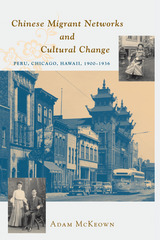
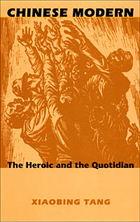
Tang uncovers crucial clues to modern Chinese literary and cultural practices through readings of Wu Jianren’s 1906 novel The Sea of Regret and works by canonical writers Lu Xun, Ding Ling, and Ba Jin. For the midcentury, he broadens his investigation by considering theatrical, cinematic, and visual materials in addition to literary texts. His reading of the 1963 play The Young Generation reveals the anxiety and terror underlying the exhilarating new socialist life portrayed on the stage. This play, enormously influential when it first appeared, illustrates the utopian vision of China’s lyrical age and its underlying discontents—both of which are critical for understanding late-twentieth-century China. Tang closes with an examination of post–Cultural Revolution nostalgia for the passion of the lyrical age.
Throughout Chinese Modern Tang suggests a historical and imaginative affinity between apparently separate literatures and cultures. He thus illuminates not only Chinese modernity but also the condition of modernity as a whole, particularly in light of the postmodern recognition that the market and commodity culture are both angel and devil. This elegantly written volume will be invaluable to students of China, Asian studies, literary criticism, and cultural studies, as well as to readers who study modernity.
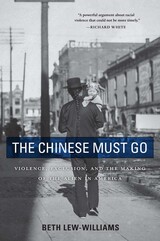
Winner of the Ray Allen Billington Prize
Winner of the Ellis W. Hawley Prize
Winner of the Sally and Ken Owens Award
Winner of the Vincent P. DeSantis Book Prize
Winner of the Caroline Bancroft History Prize
“A powerful argument about racial violence that could not be more timely.”
—Richard White
“A riveting, beautifully written account…that foregrounds Chinese voices and experiences. A timely and important contribution to our understanding of immigration and the border.”
—Karl Jacoby, author of Shadows at Dawn
In 1885, following the massacre of Chinese miners in Wyoming Territory, communities throughout California and the Pacific Northwest harassed, assaulted, and expelled thousands of Chinese immigrants. The Chinese Must Go shows how American immigration policies incited this violence, and how this gave rise to the concept of the “alien” in America.
Our story begins in the 1850s, before federal border control established strict divisions between citizens and aliens—and long before Congress passed the Chinese Restriction Act, the nation’s first attempt to bar immigration based on race and class. When this unprecedented experiment failed to slow Chinese migration, armed vigilante groups took the matter into their own hands. Fearing the spread of mob violence, policymakers redoubled their efforts to seal the borders, overhauling immigration law and transforming America’s relationship with China in the process. By tracing the idea of the alien back to this violent era, Lew-Williams offers a troubling new origin story of today’s racialized border.
“The Chinese Must Go shows how a country that was moving, in a piecemeal and halting fashion, toward an expansion of citizenship for formerly enslaved people and Native Americans, came to deny other classes of people the right to naturalize altogether…The stories of racist violence and community shunning are brutal to read.”
—Rebecca Onion, Slate
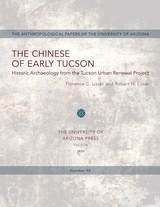
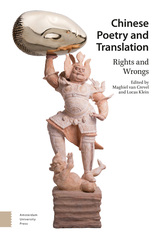

The political novel, which enjoyed a steep yet short rise to international renown between the 1830s and the 1910s, is primarily concerned with the nation’s political future. It offers a characterization of the present, a blueprint of the future, and the image of the heroes needed to get there. With the standing it gained during its meteoric rise, the political novel helped elevate the novel altogether to become the leading literary genre of the twentieth century worldwide.
Focusing on its adaptation in the Chinese context, Catherine Vance Yeh traces the genre from Disraeli’s England through Europe and the United States to East Asia. Her study goes beyond comparative approaches and nation-state- and language-centered histories of literature to examine the intrinsic connections among literary works. Through detailed studies, especially of the Chinese exemplars, Yeh explores the tensions characteristic of transcultural processes: the dynamics through which a particular, and seemingly local, literary genre goes global; the ways in which such a globalized literary genre maintains its core features while assuming local identity and interacting with local audiences and political authorities; and the relationship between the politics of form and the role of politics in literary innovation.
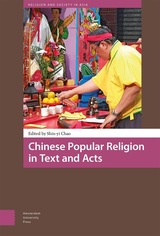

Sanchun (a pseudonym) is a small rural market center in Malaysia made up of predominantly Chinese shopkeepers, wage laborers, and rubber tappers and small holders. It is one of the so-called “new villages” originally set up during the communist insurgency as forced relocation camps to contain rural Chinese. Judith Strauch lived in Sanchun for eighteen months, conducting lengthy socioeconomic family surveys, examining local records, documents, and census data, and participating in community life.
This study offers detailed analysis of the manipulative strategies of local rivals active over several decades in the competition for local status and power. But significantly, it treats relevant aspects of the broader Malaysian political environment as well, situating local-level politics firmly in the larger context of national politics. Special attention is given to a rural mass-mobilization movement undertaken by the major Chinese-Malaysian political party in the early 1970s. The focus is on the interconnections between the various levels of a modern multi-ethnic political system, demonstrating the ways in which local political actors are both constrained and supported by power structures and resources that lie outside the local system.
The book draws together in an innovative manner important intellectual strands of both anthropology and political analysis. It should be of interest not only to Southeast Asia area specialists and students of contemporary ethnic Chinese society but also to those concerned with the problems of plural societies everywhere.

How did modern Chinese painters see landscape? Did they depict nature in the same way as premodern Chinese painters? What does the artistic perception of modern Chinese painters reveal about the relationship between artists and the nation-state? Could an understanding of modern Chinese landscape painting tell us something previously unknown about art, political change, and the epistemological and sensory regime of twentieth-century China?
Yi Gu tackles these questions by focusing on the rise of open-air painting in modern China. Chinese artists almost never painted outdoors until the late 1910s, when the New Culture Movement prompted them to embrace direct observation, linear perspective, and a conception of vision based on Cartesian optics. The new landscape practice brought with it unprecedented emphasis on perception and redefined artistic expertise. Central to the pursuit of open-air painting from the late 1910s right through to the early 1960s was a reinvigorated and ever-growing urgency to see suitably as a Chinese and to see the Chinese homeland correctly. Examining this long-overlooked ocular turn, Gu not only provides an innovative perspective from which to reflect on complicated interactions of the global and local in China, but also calls for rethinking the nature of visual modernity there.
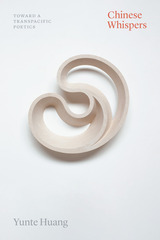
In this new book, the noted critic and best-selling author Yunte Huang explores the dynamics of poetry and poetics in the age of globalization, particularly questions of translatability, universality, and risk in the transpacific context. “Chinese whispers” refers to an American children’s game dating to the years of the Cold War, a period in which everything Chinese, or even Chinese sounding, was suspect. Taking up various manifestations of the phrase in the twentieth and twenty-first centuries, Huang investigates how poetry, always to a significant degree untranslatable, complicates the transpacific production of meanings and values.
The book opens with the efforts of I. A. Richards, arguably the founder of Anglo-American academic literary criticism, to promote Basic English in China in the early twentieth century. It culminates by resituating Ernest Fenollosa’s famous essay “The Chinese Written Character as a Medium for Poetry,” exploring the ways in which Chinese has historically enriched but also entrapped the Western conception of language.
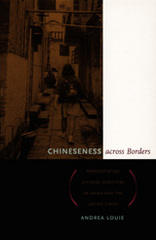
Louie focuses on “In Search of Roots,” a program that takes young Chinese American adults of Cantonese descent to visit their ancestral villages in China’s Guangdong province. Through ethnographic interviews and observation, Louie examines the experiences of Chinese Americans both during village visits in China and following their participation in the program, which she herself took part in as an intern and researcher. She presents a vivid portrait of two populations who, though connected through family ties generations back, are meeting for the first time in the context of a rapidly changing contemporary China. Louie situates the participants’ and hosts’ shifting understandings of China and Chineseness within the context of transnational flows of people, media, goods, and money; China’s political and economic policies; and the racial and cultural politics of the United States.
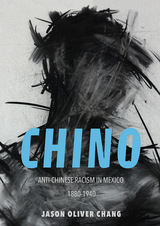
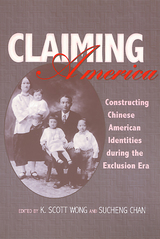
The second section shows how children of the immigrants developed a sense of themselves as having a distinct identity as Chinese Americans. For this generation, many of the opportunities available to other immigrants' children were simply inaccessible. In some districts explicit policies kept Chinese children in segregated schools; in many workplaces discriminatory practices kept them from being hired or from advancing beyond the lowest positions. In the 1930s, in fact, some Chinese Americans felt their only option was to emigrate to China, where they could find jobs better matched to their abilities. Many young Chinese women who were eager to take advantage of the educational and work options opening to women in the wider U.S. society first had to overcome their family's opposition and then racism. As the personal testimonies and historical biographies eloquently attest, these young people deeply felt the contradictions between Chinese and American ways; but they also saw themselves as having to balance the demands of the two cultures rather than as having to choose between them.

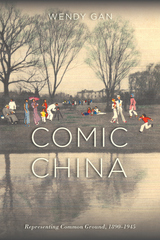
Wendy Gan’s Comic China investigates the circumstances and motivations of cross-cultural humor. How do works that trade in laughter shape our understanding of Western discourses about China? Is humor meant to be inclusive or exclusive? Does it protect or challenge the status quo? Gan suggests that the simple, straightforward laugh may actually be a far more intricate negotiation of power relations.
Gan unpacks texts by authors who had little real contact with China as well as writers whose proximity to China influenced their representations. Looking beyond the familiar canon of serious modernist texts and the Yellow Peril classics of popular fiction, Gan analyzes turn-of-the-twentieth-century musical comedies set in the Far East, Ernest Bramah’s chinoiserie-inspired tales, and interwar travel writing. She also considers the comic works of the missionary Arthur Henderson Smith, the former Maritime Customs Officer J.O.P. Bland, and the Shanghai journalist and advertising man Carl Crow.
Though it includes humor that is less than complimentary to the Chinese, Comic China reminds us that laughter is tied to our common humanity. Gan navigates the humor used in comic depictions ultimately to find, not superiority or ridicule, but common ground.

The Compelling Image will delight the art-lover who does not yet realize that Chinese painting can be as original and moving as El Greco or Cézanne. With a graceful authority, James Cahill explores the radiant painting of that tumultuous era when the collapse of the Ming Dynasty and the Manchu conquest of China dramatically changed the lives and thinking of artists and intellectuals.
The brilliant masters of the seventeenth century were reconsidering their artistic relationship to nature and to the painting of earlier times, while European pictorial arts introduced by Jesuit missionaries were profoundly influencing Chinese techniques. The reader/viewer is presented with a series of crucial distinctions of style and approach in a richly illustrated book that illuminates the whole character of Chinese painting.
Cahill begins with a relatively neglected artist, Chang Hung, who moved traditional forms ever closer to literal descriptions of nature, in contrast with the theorist painter Tung Ch’i-ch’ang, who turned the same traditional forms into powerful abstractions. A chapter focused on Wu Pin offers new and controversial ideas about the impact of European art, as well as a related phenomenon: revival of the highly descriptive early Sung styles. Looking especially at Ch’en Hung-shou, the greatest of the late Ming figure painters, Cahill examines a curious mixing of real people and conventionally rendered surroundings in portrait art of the period. He analyzes the expressionist experiments of the masters known as Individualists, and distinguishes these artists from the Orthodox school, concluding with a bold reassessment of the most eloquent of later Chinese painters, Tao-chi.
Over 250 illustrations, including twelve color plates, are drawn from collections in the United States, Europe, Japan, and China. This is a book for anyone interested in China, its past, and its art, and for the enthusiast who wishes to broaden the horizons of enjoyment by exposure to a most engaging writer on an exquisite era.

In the traditional Chinese symbolic vocabulary, the construction of gender was never far from debates about ritual propriety, desire, and even cosmic harmony. Competing Discourses maps the aesthetic and semantic meanings associated with gender in the Ming-Qing vernacular novel through close readings of five long narratives: Marriage Bonds to Awaken the World, Dream of the Red Chamber, A Country Codger's Words of Exposure, Flowers in the Mirror, and A Tale of Heroic Lovers.
Epstein argues that the authors of these novels manipulated gendered terms to achieve structural coherence. These patterns are, however, frequently at odds with other gendered structures in the texts, and authors exploited these conflicts to discuss the problem of orthodox behavior versus the cult of feeling.

Jerry Norman’s Comprehensive Manchu-English Dictionary, a substantial revision and enlargement of his Concise Manchu-English Lexicon of 1978, now long out of print, is poised to become the standard English-language resource on the Manchu language. As the dynastic language of the Qing dynasty (1644–1911), Manchu was used in official documents and was also the vehicle for an enormous translation literature, mostly from the Chinese. The new Dictionary, based exclusively on Qing sources, retains all of the information from the earlier Lexicon, but also includes hundreds of additional entries cited from original Manchu texts, enhanced cross-references, and an entirely new introduction on Manchu pronunciation and script. All content from the earlier publication has also been verified.
This final book from the preeminent Manchu linguist in the English-speaking world is a reference work that not only updates Norman’s earlier scholarship but also summarizes his decades of study of the Manchu language. The Dictionary, which represents a significant scholarly contribution to the field of Inner Asian studies and to all students and scholars of Manchu and other Tungusic and related languages around the world, will become a major tool for archival research on Chinese late imperial period history and government.

This is a dictionary of single characters which almost does the job of a dictionary of compounds. It gives the student of the Chinese language translations which translate and do not merely explain, and it offers the linguistic scholar a faithful record of current spoken Mandarin.
A comprehensive introduction on pronunciation, the system of radicals, and grammatical categories precedes the main body of the dictionary, which is arranged by radicals. An index, arranged by sounds, is included. Significant points of dialectal pronunciation, especially in Cantonese and the Wu dialects, are indicated for comparison. Neutral tones in compounds and sentences are marked throughout. The main features of dialectal pronunciation are given for each word where they differ from Mandarin.
Selection of characters is based upon authoritative frequency lists and long teaching experience. They appear in regular form, but differences between written and printed forms, together with important popular cursive variations, are also indicated. Warnings and cross-references are given to characters which are easy to confuse or hard to locate. Both National romanization and the Wade-Giles forms are given side by side. This is the first dictionary to give a full extended treatment of all the grammatical particles. The grammatical function of each word is clearly defined, and the stylistic class of each entry is either marked or implied in the translation which corresponds in style to the word translated. Important derivative words (for example, words with diminutive suffixes) and contextual words (including common synonyms and antonyms) are supplied and compared.
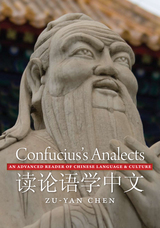
Confucius’s Analects is an innovative textbook for teaching and learning Chinese language and culture at the advanced level. It combines classical and modern Chinese language skills, Chinese culture, and expository and narrative writing practice.
Confucius's Analects is a central work of East Asian intellectual history that permeates Chinese and East Asian thought and values today. Students seeking to develop advanced language proficiency need to be familiar with the Analects in order to understand the wealth of literary allusions that appear in modern as well as classical Chinese writings. A selection of 82 passages, which are all educational and practical for present-day students, are grouped thematically into four parts—knowledge, morality, wisdom, and government—and covers Confucian teachings from personal cultivation to social contribution.
Features:• A quadrupled text system includes quotations from the Analects, modern Chinese translations of these passages, short essays of exegesis that elaborate on the major points, and historical Chinese stories that illustrate the theme• Vocabulary expansion sections show how monosyllabic classical words have each expanded into ten selected modern bisyllabic words• Almost 300 idioms and corresponding exercises teach their rhetorical value and provide cultural exposure• Sections on function words help students to understand classical Chinese• Extensive writing practice in each chapter includes debate, composition, storytelling, and topical research—all requiring internet research• Audio files of recitation of the Analects passages by a native speaker are available online for free
Designed for students who have studied Chinese for three years in college or an equivalent, this textbook is ideal for students of advanced Chinese, classical Chinese, and Chinese culture. Knowledge of classical Chinese is not a prerequisite.
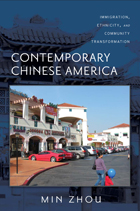
Contemporary Chinese America is the most comprehensive sociological investigation of the experiences of Chinese immigrants to the United States—and of their offspring—in the late twentieth and early twenty-first centuries. The author, Min Zhou, is a well-known sociologist of the Chinese American experience. In this volume she collects her original research on a range of subjects, including the causes and consequences of emigration from China, demographic trends of Chinese Americans, patterns of residential mobility in the U.S., Chinese American “ethnoburbs,” immigrant entrepreneurship, ethnic enclave economies, gender and work, Chinese language media, Chinese schools, and intergenerational relations. The concluding chapter, “Rethinking Assimilation,” ponders the future for Chinese Americans. Also included are an extensive bibliography and a list of recommended documentary films.
While the book is particularly well-suited for college courses in Chinese American studies, ethnic studies, Asian studies, and immigration studies, it will interest anyone who wants to more fully understand the lived experience of contemporary Chinese Americans.

The long seventeenth century in China was a period of tremendous commercial expansion, and no literary genre was better equipped to articulate its possibilities than southern drama. As a form and a practice, southern drama was in the business of world-building—both in its structural imperative to depict and reconcile the social whole and in its creation of entire economies dependent on its publication and performance. However, the early modern commercial world repelled rather than engaged most playwrights, who consigned its totems—the merchant and his money—to the margins as sources of political suspicion and cultural anxiety.
In The Cornucopian Stage, Ariel Fox examines a body of influential yet understudied plays by a circle of Suzhou playwrights who enlisted the theatrical imaginary to very different ends. In plays about long-distance traders and small-time peddlers, impossible bargains and broken contracts, strings of cash and storehouses of silver, the Suzhou circle placed commercial forms not only at center stage but at the center of a new world coming into being. Here, Fox argues, the economic character of early modern selfhood is recast as fundamentally productive—as the basis for new subject positions, new kinds of communities, and new modes of art.
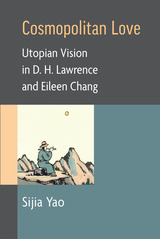

At once a revered canon associated with Confucius and the earliest anthology of poetry, the Book of Poems holds a unique place in Chinese literary history. Since early imperial times it served as an ideal of literary perfection, as it provided a basis for defining shi poetry, the most esteemed genre of elite composition. In imperial China, however, literary criticism and classical learning represented distinct fields of inquiry that differed in status, with classical learning considered more serious and prestigious. Literary critics thus highlighted connections between the Book of Poems and later verse, while classical scholars obscured the origins of their ideas in literary theory.
This book explores the mutual influence of literary and classicizing approaches, which frequently and fruitfully borrowed from one another. Drawing on a wide range of sources including commentaries, anthologies, colophons, and inscriptions, Bruce Rusk chronicles how scholars borrowed from critics without attribution and even resorted to forgery to make appealing new ideas look old. By unraveling the relationships through which classical and literary scholarship on the Book of Poems co-evolved from the Han dynasty through the Qing, this study shows that the ancient classic was the catalyst for intellectual innovation and literary invention.
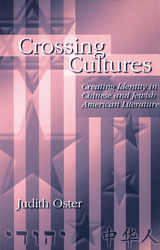

Cultural Chinese: Readings in Art, Literature, and History is an advanced language textbook with a new approach to cultural integration and immersion. In this unique book, culture becomes the very core of language learning, transitioning its role from context to text.
This textbook is ideal for courses in advanced Chinese and Chinese culture. Third- and fourth-year students and instructors will find themselves deeply immersed in the very fabric of Chinese culture that governs personal behavior and directs social dynamics.
FEATURES:
• Each of nine lessons features a distinctive topic of Chinese culture that serves as a portal to Chinese perceptions and perspectives.
• Main text of each lesson begins with a brief introduction and is further illustrated with two historical or mythological stories that inform Chinese values and attitudes.
• Additional mini-stories challenge students’ abilities of cultural interpretation.
• Includes a total of twenty-seven stories familiar to every educated Chinese person that will prepare students for meaningful communication and understanding.
• Each lesson includes more than ten sections of exercises intertwined with culture, including vocabulary and idioms, historical information, linguistic points, translation exercises, and online research required for debate, composition, and storytelling.
READERS
Browse our collection.
PUBLISHERS
See BiblioVault's publisher services.
STUDENT SERVICES
Files for college accessibility offices.
UChicago Accessibility Resources
home | accessibility | search | about | contact us
BiblioVault ® 2001 - 2024
The University of Chicago Press









